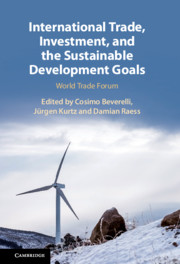Book contents
- International Trade, Investment, and the Sustainable Development Goals
- International Trade, Investment, and the Sustainable Development Goals
- Copyright page
- Contents
- Figures
- Tables
- Contributors
- Preface
- Introduction
- Part I Penetration and Diffusion of the Sustainable Development Goals
- Part II Top-Down: Public Approaches to Achieving the Sustainable Development Goals
- Part III Bottom-Up: Private Sector and Civil Society Initiatives on the Sustainable Development Goals
- 6 Voluntary Standards, Trade, and Sustainable Development
- 7 The Role of Voluntary Sustainability Standards in Sustainable Livelihoods for Cocoa Farmers in Côte d’Ivoire
- 8 Unblocking the Trade Pipes
- 9 The Effects of Environmental Costs on Public Support for Foreign Direct Investment
- Conclusion
- Index
- References
Conclusion
from Part III - Bottom-Up: Private Sector and Civil Society Initiatives on the Sustainable Development Goals
Published online by Cambridge University Press: 18 September 2020
- International Trade, Investment, and the Sustainable Development Goals
- International Trade, Investment, and the Sustainable Development Goals
- Copyright page
- Contents
- Figures
- Tables
- Contributors
- Preface
- Introduction
- Part I Penetration and Diffusion of the Sustainable Development Goals
- Part II Top-Down: Public Approaches to Achieving the Sustainable Development Goals
- Part III Bottom-Up: Private Sector and Civil Society Initiatives on the Sustainable Development Goals
- 6 Voluntary Standards, Trade, and Sustainable Development
- 7 The Role of Voluntary Sustainability Standards in Sustainable Livelihoods for Cocoa Farmers in Côte d’Ivoire
- 8 Unblocking the Trade Pipes
- 9 The Effects of Environmental Costs on Public Support for Foreign Direct Investment
- Conclusion
- Index
- References
Summary
The chapters in this volume have shown that international trade and foreign investment can contribute in different ways to achieving the Sustainable Development Goals (SDGs) at all levels, be it international, supranational, transnational, national or subnational.
- Type
- Chapter
- Information
- International Trade, Investment, and the Sustainable Development GoalsWorld Trade Forum, pp. 310 - 315Publisher: Cambridge University PressPrint publication year: 2020

